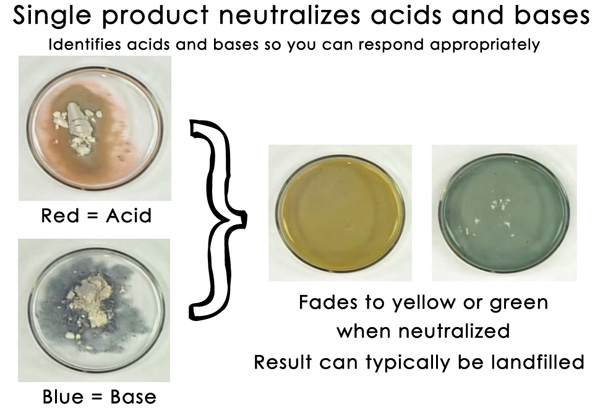Know Your Chemicals - a Lab Safety Guide by AmphoMag
AmphoMag®* has recently released an article on laboratory safety and how to protect yourself against various commonly used chemicals. Below is a synopsis of their findings.

Amphomag® is a universal chemical spill neutralizer using rapid response chemistry to safely absorb and treat spills of any kind. It is used in labs to neutralize acids, bases, and gases; absorb liquids; and control odors.
Laboratory workers are at risk of exposure to the chemicals in the lab, and precautions are necessary to ensure their physical health and safety. Most essential is understanding the chemicals you are dealing with. What makes them hazardous? How should they be handled? What risks do they pose? How do you clean them up if spilled?
Formaldehyde is a common chemical used in a variety of products. It can cause respiratory irritation if inhaled, such as coughing, wheezing, and chest pains, and can affect people with asthma, allergies, or other breathing issues more acutely. If formaldehyde comes in contact with the skin, it can cause irritations like dermatitis or even burns. People with frequent exposure to formaldehyde, like some lab techs, become more sensitive to these negative effects. Amphomag® formaldehyde clean-up instructions.
Hydrochloric Acid. Use extreme care in handling this extremely corrosive, poisonous acid, which can cause severe damage to all body tissues. If a small amount of the acid is spilled, it should immediately be contained and neutralized to prevent harm to anyone or damage to whatever it was spilled on. When using hydrochloric acid, always wear protective clothing and gear, such as eye goggles and gloves. Amphomag® hydrochloric acid clean-up instructions.

Hydrofluoric Acid. Certain spill response products, like clay absorbents, cannot be used on a hydrofluoric acid spill. Attempted use of these products to treat a hydrofluoric acid spill could create a dangerous gas. Due to the limitations of these products, it is important to understand what can and cannot be used to neutralize a hazardous hydrofluoric acid spill. Amphomag® hydrofluoric acid clean-up instructions.
Nitric Acid is a dangerous chemical that dissolves metals such as iron, copper, and silver. Commonly used in fertilizer production for plants and grass, nitric acid can also be seen in facilities that have a business in woodworking, sanitizing, rocket propulsion, and metal finishing. Workers should wear protective equipment such as gloves or face shields to prevent inhalation and contact with skin. Amphomag® nitric acid clean-up instructions.
Phosphoric acid is a clear liquid or a transparent crystalline solid. It is widely used in the manufacturing of food additives, fertilizers, cleaning products, and water treatment. Phosphoric acid can damage the lungs through inhalation. Breathing may cause irritation to the nose and throat if a worker is not careful. Amphomag® phosphoric acid clean-up instructions.
Sulfuric acid is a strong acid that can burn through clothes and skin; making a sulfuric acid spill a potentially dangerous situation. Before dealing with the sulfuric acid spill itself, first check yourself to see if any acid got on you — or anyone else who is around — and wash off/rinse thoroughly any acid found. Amphomag® sulfuric acid clean-up instructions.
*Article has been edited. View the original story at http://www.amphomag.com/laboratory-safety
Recent Posts
-
Safety First: Choosing the Right PPE for Your Laboratory
Are you aware that over 20,000 workplace injuries occur annually i …1st Oct 2025 -
The Future of Lab Supplies: Trends You Can't Ignore
As laboratories across various industries evolve, the demand for i …29th Sep 2025 -
Ergonomics in the Lab: Choosing Equipment for Comfort
In the fast-paced world of laboratory work, comfort should not be …15th Sep 2025
